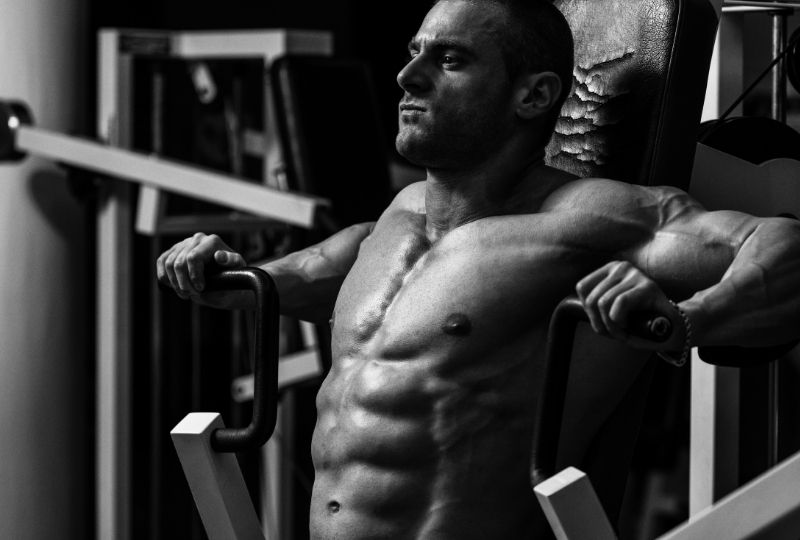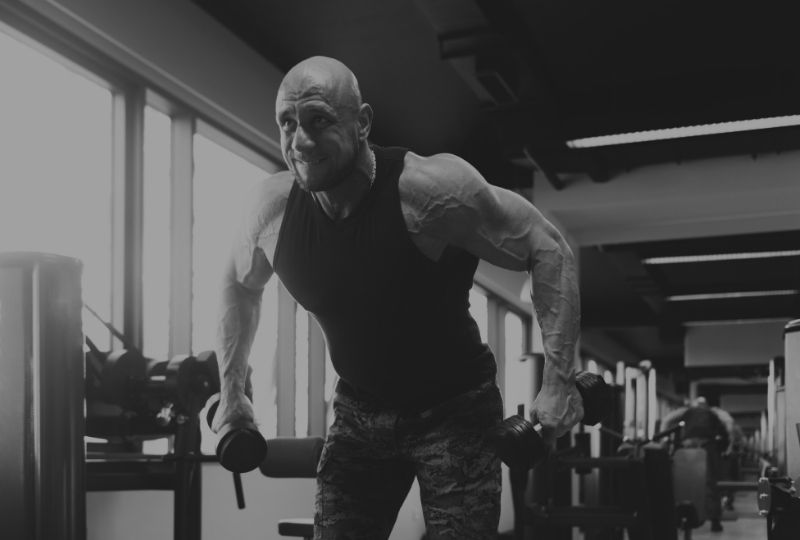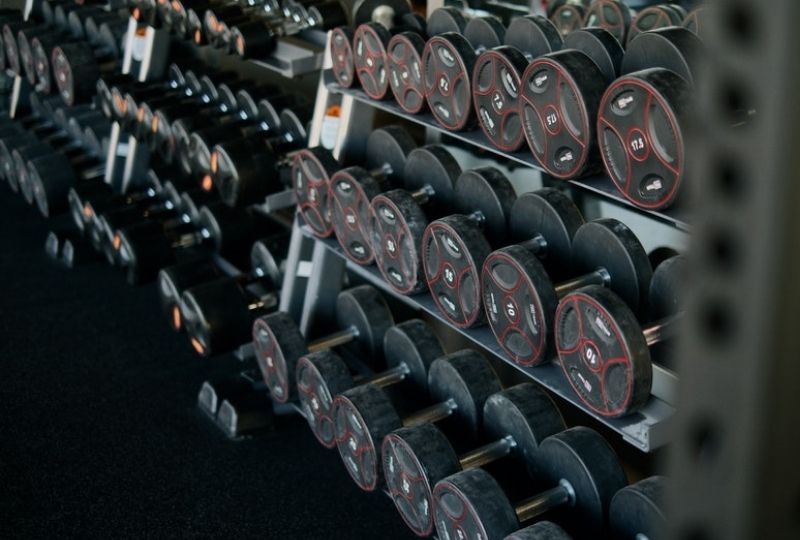What's inside
When you ask people who their inspiration for the gym is, certain names will pop up time and time again.
Superhuman figures like Hercules or Batman aside, one of the biggest gym heroes in history has to be Arnold Schwarzenegger.
Arnold had one of the best physiques in bodybuilding history, but he also had charisma and a mindset that made him popular worldwide.
Because Arnold is an icon to so many starting their weightlifting journeys, many people are interested to know what his methods in the gym were.
This article is a guide to the Arnold split, the training program used by Arnold in his heyday.
We’ve included the training schedules, workouts, and exercises you’ll need to train like Arnold.
In addition, there are a bunch of tips for advanced, high-intensity training to really produce that extra growth.
So read on, and while not everyone aspires to be Mr. Olympia, you may well be on your way!
Arnold’s Bodybuilding Story
After developing a passion for weightlifting at a young age, Arnie entered the European bodybuilding scene in the mid-sixties, then headed off to chase glory in the United States.
By the early seventies, Arnold had won titles in Mr. World, Mr. Universe, and his first Mr. Olympia.
Arnold of course went on to win six Mr. Olympia titles – including the famous battles against Lou Ferrigno, the basis of the cult film Pumping Iron.
Not only looked up to by aspiring bodybuilders, Arnie has a great philosophy that has led him to success in many areas of life.
With that said, let’s take a look at the way Arnold trained to achieve such huge success in the world of bodybuilding.
What is the Arnold Split?
The Arnold split refers to the style of training adopted by Arnold for the majority of his professional bodybuilding career.
Referenced in his training ‘bible’, The New Encyclopedia of Modern Bodybuilding, there are a couple of programs that can be considered Arnold splits.
The first is a 3 day split, hitting each muscle group twice per week for a total of six training days.
The more advanced version adopted by Arnold to keep his training intensity high was a double-split program. For this, he trained twice daily on certain days to break up the workload.
This Arnold split allowed him to hit each muscle group three times per week, with a total of nine workout sessions over six days:
Weekly Schedule:
- Version 1 – 6x per week
- Monday: Chest + Back
- Tuesday: Shoulders + Arms
- Wednesday: Legs + Lower back
- Thursday: Chest + Back
- Friday: Shoulders + Arms
- Saturday: Legs + Lower back
- Sunday: Rest
- Every session: Abs
Version 2 – 9x per week Double-split
- Monday morning: Chest + Back
- Monday afternoon: Legs + Lower back
- Tuesday: Shoulders + Arms
- Wednesday morning: Chest + Back
- Wednesday afternoon: Legs + Lower back
- Thursday: Shoulders + Arms
- Friday morning: Chest + Back
- Friday afternoon: Legs + Lower back
- Saturday: Shoulders + Arms
- Sunday: Rest
- Every session: Abs + Calves
These splits are backed by science for their effect on muscle growth, with a frequency of at least twice per week showing the best outcomes for hypertrophy.
Another unique characteristic of the Arnold split was the grouping of muscles worked in certain sessions.
For example, unlike many popular splits today which separate push and pull, or chest and back, Arnold trained the large upper body muscles together.
He also trained often-forgotten muscle groups like the abs and calves each and every session.
The Arnold split comes from the golden age of bodybuilding and features many staple exercises.
Arnold believed in the fundamentals, with moves such as the classic squat, bench press and barbell rows being heavily favored for the lifting of heavy weight.
While the results of Arnold’s training program can clearly be seen in the immortal images of the man himself, the next section will discuss the pros and cons of such a program for the average lifter.
Benefits of the Arnold Split Workout
Related: Reverse Pyramid Training
The Arnold split obviously has merit when talking about high-level bodybuilding.
While the focus was on muscle mass and aesthetics, the Arnold split is also effective for those who want to build serious strength.
The more advanced Arnold split allows training with high intensity for every set.
This will ensure maximal gains, even in the muscle groups that typically get trained later in the session.
Training like Arnold will also ensure the progress keeps coming consistently, as you’ll see with the many advanced techniques provided in later sections.
Drawbacks of the Arnold Split
As effective as training with the Arnold split is, it might not necessarily be the best approach for everybody.
Even the more basic split in this article may be too advanced for those just getting introduced to weightlifting.
As tempting as it is to train like Arnold, it’s important to start at the appropriate level to avoid injury or overtraining.
Another point that must be mentioned is that while legal during his competitive years, Arnold was using performance-enhancing drugs.
This allowed him to train super hard with a very high frequency, but the same style of training might need to be adjusted for natural lifters.
What is the Arnold Blueprint to Mass?
The Arnold Blueprint is a series released by bodybuilding.com with a great range of video interviews with an older but wiser Arnold.
The Blueprint includes videos on Arnold’s training mentality, nutrition, and tips on training for mass or on cutting for competition.
The Arnold Blueprint is well worth checking out, although the workouts and tips in this article are more based on Arnold’s books.
Arnold Split Workout Routine Overview
Related: 4 Day Workout Split
Now we come to the main attraction. The actual Arnold split workout program!
The workouts in this guide follow the same split routine used by Arnold for much of his bodybuilding career.
You can perform either the basic or advanced split using the workouts here.
To reiterate those here for convenience, the basic split is this:
Basic Arnold Split
| Monday / Thursday | Chest + Back |
| Tuesday / Friday | Shoulders + Arms |
| Wednesday / Saturday | Legs + Lower Back |
| Every session | Abs |
| Sunday | Rest |
For those with the time, training level, and sheer willpower, here is the advanced version again:
Advanced Arnold Split
| Monday / Wednesday / Friday Morning | Chest + Back |
| Monday / Wednesday / Friday Evening | Legs + Lower Back |
| Tuesday / Thursday / Saturday | Shoulders + Arms |
| Every session | Abs + Calves |
| Sunday | Rest |
Now we’ve established the schedule of the Arnold split, here are the actual workouts.
Schwarzenegger Chest & Back Workout

The first session is chest and back, a somewhat unique combination by today’s standards.
The closest modern-day session to this would be something like an upper-body day without the shoulder and arm work.
This session is full of big, bang-for-your-buck compound lifts for the large chest and back muscles.
For the initial bench press, including a few warm-up sets of 15, 12, and 10 repetitions, or something similar.
| Exercise | Sets x Reps | Rest |
| Bench press | 3×8 | 1-3 min |
| Incline bench press | 3×10 | 1 min |
| Dumbbell fly | 3×12 | 1 min |
| Chin-ups | 50 reps total* | 1 min |
| Bent-over rows | 3×8 | 1-3 min |
| Deadlift | 3×10/6/4 | 3-5 min |
| Crunches | 5×25 | 30 sec – 1 min |
Schwarzenegger Shoulders & Arms Workout

Next, we have the longer workout of the Arnold split, on the days where there is only one training session.
While the exercise list looks quite long initially, these smaller muscle groups are able to be trained with less rest while still at a high intensity.
If you wanted to keep the same gym schedule each day, you could theoretically split this up into shoulders in the morning and arms in the evening.
Again, include an adequate warm-up routine before going into your heavy overhead pressing movements.
After that, most of these exercises are less about lifting heavy weight, and more about focusing on a strong mind-muscle connection and pushing to failure and beyond.
| Exercise | Sets x Reps | Rest |
| Barbell overhead press | 3×8 | 1-3 min |
| Lateral raise | 3×10 | 1 min |
| Upright row | 3×10/6/4 | 1-3 min |
| Rear delt fly | 3×12 | 1 min |
| Barbell curl | 5×15/10/8/6/4 | 1 min |
| Incline dumbbell curl | 3×8 | 1 min |
| Close-grip bench press | 4×15/10/8/6 | 1 min |
| Overhead tricep extension | 3×8 | 1 min |
| Wrist extensions | 3×10 | Superset |
| Wrist flexions | 3×10 | 1 min |
| Reverse crunch | 5×25 | 30 sec – 1 min |
Schwarzenegger Legs & Lower Back Workout
Finally, we have the lower body part of the Arnold split. Arnold touted the simple barbell squat as one of the fundamental exercises for building strong legs.
After blasting the legs with squats, it’s time to start some single leg work with lunges, focusing on getting a good stretch in the glutes.
Next are some quad, hamstring and calve isolation moves to target different areas of the leg musculature.
To finish up, this workout includes some straight-legged deads and back extensions to create thick and aesthetic spinal erector muscles.
| Exercise | Sets x Reps | Rest |
| Squats | 5×20/10/8/6/4 | 1-5 min |
| Lunges | 3×10 | 1 min |
| Leg curls | 4×10 | 1-3 min |
| Standing calf raise | 4×10-15 | 1 min |
| Straight legged deadlift | 3×10/6/4 | 1 min |
| Back extension | 3×10 | 1 min |
| Decline bench twists | 100 reps total (each side) | Minimal |
Schwarzenegger Abs Workout
As mentioned previously, Arnold would train the abs during every session.
While the basic Arnold split involves multiple sets of a single core exercise at the end of each session, the more advanced version would look something like this:
| Exercise | Sets x Reps | Rest |
| Roman chair situps | 5 mins | Minimal |
| Machine crunches | 3×25 | 1 min |
| Hanging knee raise | 4×25 | 1 min |
| Decline bench twists | 100 reps total (each side) | Minimal |
You can perform a full ab routine like this one if you have the time or if you want to focus more on the abs as a muscle group.
A full ab workout like this is best done every second day, with a single exercise tacked on to the end of every other workout, if necessary.
What was Arnold’s dieting plan?

Arnold kept a relatively simple approach to his eating regime, even at the peak of his bodybuilding career.
While famous stories of him eating entire chickens and downing beer by the pint after workouts are hilarious, Arnold was more practical with his diet long-term.
First, he maintained around 40% protein, 40% carbs, and 20% fats in terms of macronutrients.
Arnold aimed for one gram of protein per pound of bodyweight, which he would get through a combination of whole foods and protein supplements.
The combination of resistance exercise and protein ingestion is critical for muscle mass, with protein uptake by the muscles elevated for around 24 hours after a training session.
Arnold was not a big eater, so he preferred the method of having five meals a day to avoid having to shovel copious amounts of food down in one sitting.
As for micronutrients, Arnie ate a balanced diet and used supplements to ensure adequate intake of all essential vitamins and minerals.
He didn’t believe in cutting out entire food groups to not miss out on their nutritional benefits.
Arnold had a reasonably simple diet, consisting of foods like eggs, bacon, and milk for breakfast, meat, poultry, or fish with vegetables for lunch and dinner, and protein shakes.
Here are the recommended sources of macronutrients from Arnold’s encyclopedia:
| Protein | Carbohydrates | Fats |
| Fish | Vegetables | Avocados |
| Poultry | Salads | Olive oil |
| Eggs | Fruits | Nuts |
| Low-fat milk + dairy | Fresh beans | Fish |
| Protein powder | Whole grain/rye bread | |
| Lean meats | Rice (not white) |
If you aim to build muscle, Arnold’s recommendations revolved around getting enough protein and being in a mild to moderate calorie surplus.
As for losing body fat, he was very conscious of not losing any of his hard-earned muscle.
This was achieved by keeping protein high, eating about 20% of calories from fat, lowering carbohydrate intake, and performing 45-60 minutes of cardio 4-5 days a week.
Arnold was adamant about not being too strict with diet, starting gradually and continuing as long as you are seeing gradual progress.
This fundamental approach to nutrition is supported by research as the safest and most effective way to lose body fat long term.
When it came to contest prep, Arnie also liked to keep it simple, preferring to stay reasonably lean in the offseason to avoid losing muscle through aggressive cutting.
Preparing for an event like Mr. Olympia involved writing down and tracking everything he ate and more advanced strategies around hydration and other performance-enhancing substances.
While professional bodybuilding can involve intense focus on a diet, Arnold’s advice to the regular gym-goer looking to gain some muscle and lean down a bit has stood the test of time.
Arnold’s Training Methods for Muscle Growth

When training at the level of a Mr. Olympia, standard training programs – no matter how advanced – isn’t going to cut it for achieving that extra edge.
There’s only so much progress to be achieved by increasing load and volume, and only so much time can one train at a high intensity.
Arnold employed a wide range of advanced training techniques to ensure the gains continued even at the highest level.
Such methods have been found in studies to achieve greater muscle growth by increasing mechanical tension, muscle damage, and metabolic stress in the muscles.
The following list includes many such techniques that you can use when you feel like a particular exercise or muscle group needs an extra kick to grow.
1. Shocking Principle
This first tip is simply to do something different when you feel your muscles have stopped responding to your program.
Techniques to shock the muscles include drastically changing the weight, increasing the reps, working at a different cadence, or shortening rest breaks.
The point is that the body can adapt even to huge stresses, so it pays to throw a curveball at it now and then to force new growth.
2. Forced Reps
While the traditional method of having a workout partner help with the concentric portion of the lift is commonly used, Arnold preferred another way to get a few extra reps.
Instead of having a partner help too much (or too little), Arnold would use rest-pause sets to achieve those extra critical repetitions.
To do a rest-pause set, simply work until initial failure, drop the weight if possible, rest just a few seconds, then continue the set.
Repeat one to several times as needed for maximum effect.
3. Partial Reps
Arnold liked partial reps for most muscles in the body. While you may have seen this technique before, there is a particular way Arnold did them, which is worth noting.
The method used by Arnold was to work to failure in a set, then perform partial reps in different ranges of motion.
For example, on concentration curls, complete as many total reps as possible. Then use the off-hand to help the weight up and perform several reps at the top of the movement.
Work your way down, performing another few in the middle range, and finally a couple more to complete exhaustion at the bottom of the curl.
4. Negatives
‘Negatives’ is the name given to the eccentric portion of a lift or the lowering of the weight against gravity.
The other characteristic of an eccentric or negative movement is that the muscle is lengthening under tension rather than shortening.
This technique has a lot of research backing it up. This study explains that the specialized neural pattern of eccentric loading makes it superior for muscle mass and strength gains.
Negatives can be performed at the end of a set, where you get assistance or safely cheat the weight up and do a few slow, controlled negatives.
Alternatively, you can do an entire set of negatives, allowing you to use heavier weights than you usually can for a particular exercise.
5. Priority Principle
Rather than a specific technique to use during a set, the priority principle is a method of exercise order in your program.
Arnold used the priority principle to bring up any weak or lacking body parts, which you can also do for your physique.
To prioritize a specific muscle group, program exercises first in the workout, first after rest days, or employ additional volume and intensity techniques for that muscle.
6. Supersets
A popular technique, supersets can be done in multiple ways to add a different spin to your training.
The first method involves performing two consecutive exercises for the same muscle group, squeezing every bit.
Alternatively, Arnold was a particular fan of supersets using two different muscle groups, both for cardiovascular conditioning and the tremendous pump.
Supersets can also be taken further with tri-sets or even ‘giant sets’ of four exercises in a row.
7. Stripping Method
Also known as drop sets, or ‘running the rack’ when using dumbbells, the stripping method involves lowering the weight slightly and continuing a set past failure.
This method works well with a workout partner ready to strip plates of a bar, for example, or with pin-loaded machines where you can quickly decrease the weight and keep going.
Drop sets are supported in the scientific literature as one method for increasing the mechanical tension on the muscle.
Arnold recommended only performing this method on the last set of an exercise to ensure you can lift the heaviest weight in the main working sets.
8. Isotension Principle
While this technique may be familiar to bodybuilders, many people reading might not know this unique principle.
This technique involves flexing a muscle between sets for a strong isometric contraction.
This can include performing certain poses relevant to the muscle being worked for a bodybuilder.
Arnold touted this method as essential for anyone looking to win a major bodybuilding championship.
For more information, check out our article on the does flexing build muscle.
9. Pre-Exhaust Principle
This is a great technique for maximizing the benefit of compound exercises for smaller muscle groups.
Pre-exhausting involves performing an isolation exercise on the larger muscle before going into a compound lift.
For example, say your chest can handle heavy weight on a bench press, but your shoulders or triceps struggle to lock the weight out.
Try using the pre-exhaust method by performing a set of chest flys prior to your bench press.
The pecs will be more fatigued, meaning you won’t be able to lift as much overall weight, but the smaller muscles will be forced to work harder.
This will lead to them growing stronger and increasing your overall strength and muscularity.
10. Flushing Method
The flushing method is performing isometric holds at various portions of a range of motion.
This technique is great for building a mind-muscle connection at every part of a movement and creating more metabolic stress in the muscle to force growth.
Choose a compound exercise like a leg press or an isolation move like a lateral raise.
Perform reps by moving through the range of motion several inches at a time, pausing for up to 10 seconds at each point.
11. One-and-a-Half Method
This simple but effective technique entails performing a half-range rep with a brief pause in between each regular repetition.
This method can be done at the top or bottom portion of the exercise in most cases.
For example, you can do a one-and-a-half with the lockout of a bench press or the bottom lift-off, depending on which is a weak point for you.
12. Platoon System
Also known as ‘21s’, the platoon system is a more advanced version of one-and-a-halfs.
This technique is done by performing seven reps in the lower half of an exercise, seven in the top half, and finally seven with a full range of motion.
Arnold would do this method using 10 repetitions of each range, but any number of reps can be used.
13. Ballistic Training
Great for building explosive power, ballistic training is best done with large compound movements such as squatting or pressing.
This method involves driving the weight up concentrically as fast as possible.
Ballistic training is excellent for blasting through sticking points and stimulating the fast-twitch muscle fibers.
This is important for muscle size as fast-twitch fibers are significantly larger than slow-twitch muscle fibers.
Frequently asked questions
Related: Greek God Physique
How many hours did Arnold train a day?
At the peak of his career, Arnold would perform up to 75 sets of workouts. This would take up to three hours, which is why he would split sessions to train twice daily.
Being a professional bodybuilder means balancing training for long periods and training at high intensities.
How often did Arnold train arms?
In the advanced training program based on Arnold’s split, each body part is trained three times per week.
Arnold would train biceps, triceps, and forearms in the same session. Of course, the muscle groups of the arm can be split into separate workouts, and still be hit three times per week.
How many times a day did Arnold Schwarzenegger train?
After realizing he couldn’t train his legs with enough intensity after working chest and back, Arnold discovered double-split training.
He would do one session in the morning – for example, chest and back – then come back in the evening after 8-10 hours of rest to train legs.
How often did Arnold do cardio?
Arnold was (and still is) a proponent of undergoing regular aerobic exercise for cardiovascular fitness and overall health.
Arnold would perform 30 minutes of different forms of cardio, four to five days per week.
This is in line with the ACSM recommendation of 150 minutes of moderate-intensity aerobic activity per week.
Arnold Split vs. PPL
Related: Bro Split vs PPL
When comparing an advanced bodybuilding program like the Arnold split to a push/pull/legs 3-day split has more similarities than you might think.
Both involve training six days per week, although the advanced Arnold split involves nine sessions instead of six.
The basic Arnold split has a slightly different configuration than PPL. Instead of chest and back, a push day targets chest, shoulders, and triceps. Meanwhile, a pull day hits the back and biceps.
The main difference between the two programs is training level and personal preference, so try both and see what works best for you.
Hasta La Vista, Baby
So, what do you think of the Arnold split? Is it something you’d like to use, or are you happy to leave it to guys like the former Mr. Olympia to perform programs like this?
Let us know your thoughts on Arnold’s training methods and philosophy in the comments!
If you know anyone who might want some insight into exactly how Arnold trained back in the day, please share this article with them, too.

